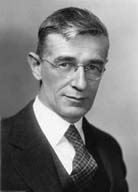 Vannevar Bush (March 11, 1890 – June 28, 1974; was an American engineer and science administrator known for his work on analog computing, his role in the development of the atomic bomb as a primary organizer of the Manhattan Project, and the idea of the memex, a method to organize and retrieve data. As Director of the Office of Scientific Research and Development, Bush coordinated the activities of some six thousand leading American scientists in the application of science to warfare.
Vannevar Bush (March 11, 1890 – June 28, 1974; was an American engineer and science administrator known for his work on analog computing, his role in the development of the atomic bomb as a primary organizer of the Manhattan Project, and the idea of the memex, a method to organize and retrieve data. As Director of the Office of Scientific Research and Development, Bush coordinated the activities of some six thousand leading American scientists in the application of science to warfare.
Bush was a well-known policymaker and public intellectual during World War II and the ensuing Cold War, and was in effect the first presidential science advisor. Bush was a proponent of democratic technocracy and of the centrality of technological innovation and entrepreneurship for both economic and geopolitical security.
Bush was educated at Tufts College, graduating in 1913. He then worked at General Electric, taught mathematics at Jackson College, then received a doctorate in engineering from MIT and Harvard University, jointly, in 1917.
During World War I he worked with the National Research Council with about six thousand leading American scientists in the application of science to warfare (such as developing submarines, trip hammers, and better microscopes). He joined the Department of Electrical Engineering at MIT in 1919 and was a professor there from 1923–32.
During 1922, Bush and his college roommate, Laurence K. Marshall, set up the American Appliance Company to market a device called the S-tube. This was a gaseous rectifier invented by C. G. Smith that greatly improved the efficiency of radios. Bush made much money from the venture. The company, renamed Raytheon, became a large electronics company and defense contractor.
Starting in 1927, Bush constructed a Differential Analyser, an analog computer that could solve differential equations with as many as 18 independent variables. An offshoot of the work at MIT was the beginning of digital circuit design theory by one of Bush's graduate students, Claude Shannon.
Bush was vice-president and dean of engineering at MIT from 1932 to 1938. In June 1940 he convinced Franklin Delano Roosevelt to give him funding and political support to create a new kind of collaborative relationship between military, industry, and academic researchers--without congressional, or nearly any other, oversight.
During 1939 Bush accepted a prestigious appointment as president of the Carnegie Institution of Washington, which awarded large sums annually for research. As president, Bush was able to influence research in the U.S. towards military objectives and could informally advise the government on scientific matters. During 1939 he became fully involved with politics with his appointment as chairman of National Advisory Committee for Aeronautics, which he directed through 1941.
Early in 1940, Bush proposed the National Defense Research Committee (NDRC) which was later subsumed into the Office of Scientific Research and Development (OSRD) with Bush as director. The OSRD controlled the Manhattan Project and which also coordinated scientific research during World War II. In all, OSRD directed 30,000 men and oversaw development of some 200 weapons and instrumentalities of war, including sonar, radar, the proximity fuze, amphibious vehicles, and the Norden bomb sight, all considered critical in winning the war. At one time, two-thirds of all the nation’s physicists were working under Bush’s direction. In addition, OSRD contributed to many advances of the physical sciences and medicine, including the mass production of penicillin and sulfa drugs.
After World War II, Bush encouraged the organization of a peacetime research and development agency would replace the OSRD. His recommendation eventually led to the creation of the National Science Foundation (NSF).
During 1955 Bush retired as President of the Carnegie Institution and returned to Massachusetts. From 1957 to 1962 he was chairman of the large pharmaceutical corporation Merck & Co. Bush returned to the Massachusetts Institute of Technology in 1955, where he stayed until retirement in 1971.